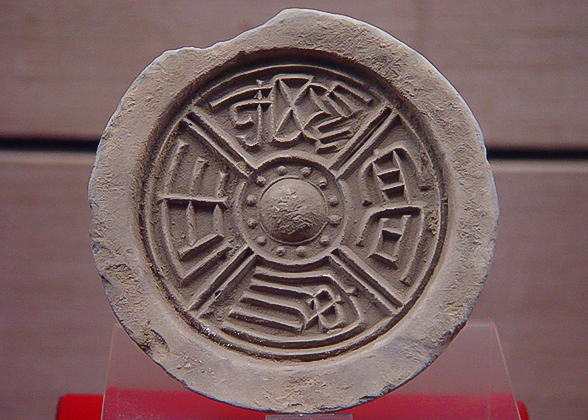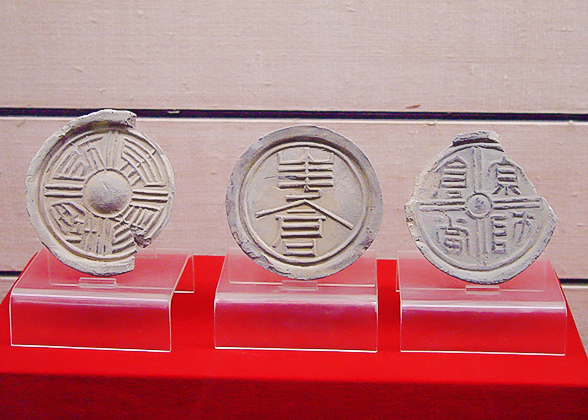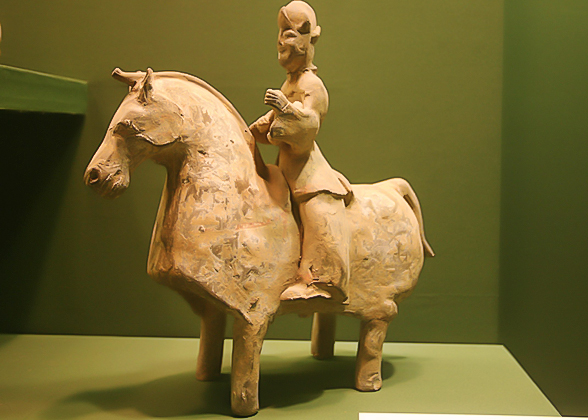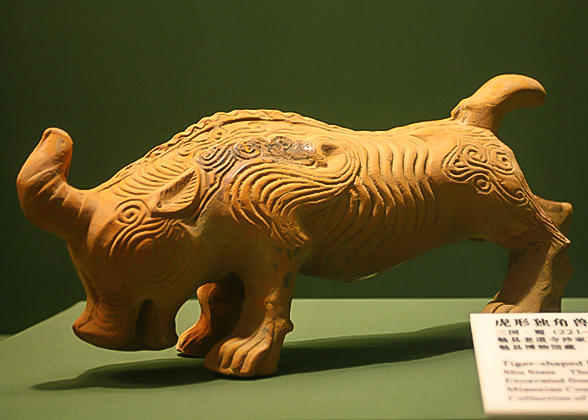Exhibition Hall No. 2 of Shaanxi History Museum
Exhibition Hall No. 2 is on the second floor of Shaanxi History Museum, where it exhibits cultural relics of the Han Dynasty(202 BC-220 AD) and Wei, Jin, Southern and Southern and Northern Dynasties (220-589) in two units.
(202 BC-220 AD)
The Han Dynasty is the first era to be shown. It was with the development of the Han culture that the first peak of the historic Chinese feudal system was established. Present day Xi'an was known as Chang’an in those days and general information about the city is displayed at the entrance of this hall. Three sections are covered in this unit, the Chang’an City in Han Dynasty, the feudal economy and the social life.
In the section covering the culture of Chang’an City, the most famous relics are the four tiles each bearing one of four deities on them. These deities are the green dragon, the white tiger, the rose finch and the tortoise. These represented the four seasons as well as the four cardinal compass points in ancient times. Tiles dating from the Han Dynasty are famous for the designs with propitious characters or names of palaces on them. Here you can see also the Empress' Jade Seal inscribed with the characters “Huang Hou Zhi Xi”, which probably belonged to Empress Lv, wife of Liu Bang, the first Han Dynasty emperor and is a national treasure.
Relics relating to the economy, agriculture and transportation in second and third sections will surely surprise you when you see how these ancient people progressed in material, cultural and ideological matters during the Han Dynasty.
A gilded incense burner used by Emperor Wu (the seventh emperor of Han Dynasty) is a must-see relic. On the base are two curled-up dragons, another three dragons are carved on the top of the handle to support the incense burner, while on the body there are four more dragons. The nine dragons are a symbol of emperor in ancient Chinese culture. The upper part of the burner is decorated with mountains that are surrounded in mist as the incense burned, creating a fairyland appearance. Besides this delicate relic, you can see a series of exquisite currency made under Wang Mang’s regime (a dynasty from 9 to 23 AD, which followed the Western Han Dynasty and preceded the Eastern Han Dynasty).
As a consequence of this highly developed and peaceful society, the social life of the people became colorful. Technology also flourished in this period. Measuring devices, the earliest accounting tools and paper appeared in this period and you can see all of them in this hall. A lamp, whose shape is like a wild goose holding a fish in its mouth, deserves special attention. Because ancient people used oil to light their houses, the smoke from this oil would be harmful to the environment. However, for this lamp, the smoke went through the long neck of the goose into its body which contained water, making it an environmental friendly lamp. Another delicate article is a mirror which uses the principle of diffusion to reflect patterns or characters from its back to the wall when it is under light. The last section deals with the Han culture, which was the largest and strongest ethnic group during Han Dynasty.
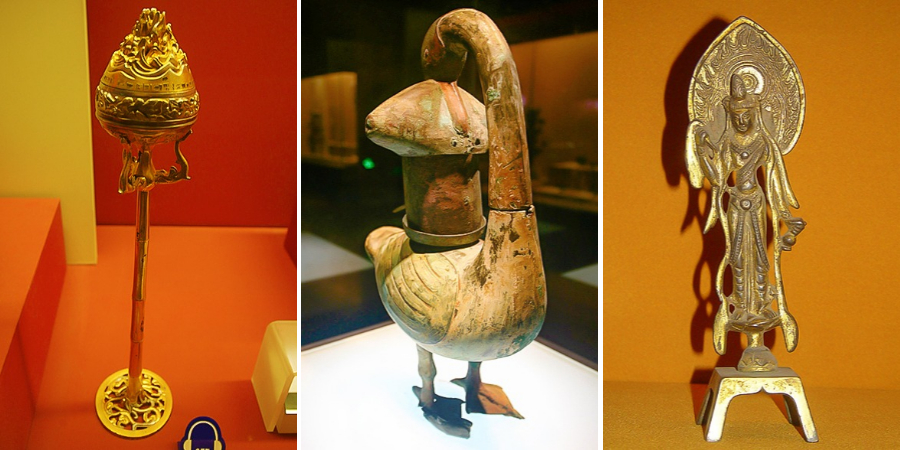
During the Han Dynasty, Zhang Qian was an imperial envoy to states beyond China although the Han first communicated with the other ethnic minorities within China seeking alliances to fend off attacks by the Huns. It is interesting to see that pottery horses became larger with characteristics of the Hun in this period. The fragments of silk as well as other relics are historical records of the time. A golden monster stands out in this section. Although it is referred to as a monster, it is not as big as a monster in Western myths. Scholars suggest that this mythical beast decorated the hats of Hun leaders. It has a sheep-like body, a beak like an eagle, antlers like a deer and a tail like a scorpion. Nobody knows what it is, so they call it monster. If you observe it clearly, you will find that there are 16 birds on its body and one on its tail. You cannot help but praise craftsman’s skill when you see it.
 Relics of Han Dynasty Photos
Relics of Han Dynasty Photos
(220 - 589)
Following the demise of the Han Dynasty, the Wei, Jin, Southern and Northern Dynasties ruled but it was a period of continual warring between the various dynasties. In this unit, the exhibition is divided into five parts: recording the wars between Wei and Jin Dynasties, the Southern and Northern Dynasty, the combination of different minorities and the art and culture of Buddhism. Because of the continual wars between Wei and Jin, relics in this period are almost all weapons such as crossbows, spurs and regional articles like military officer figurines with different characteristics. During the Southern and Northern Dynasties, many minorities came to the central plains, most of them settled in Shaanxi Province, which was the center of different nationalities at that time. All kinds of pottery figurines in the museum give you a chance to enjoy the diversity of those times.
The last part concerns the origins of Buddhism in China, how it came into the country and spread throughout the land. Many Buddhist statues, temples and grottoes were created and developed at an unprecedented rate. Many statues of different kinds of Buddha are on display, from which you can get to know something of the origin of Chinese Buddhist culture and the differences between Chinese Buddhism and that of India.
 Photos of Relics of Wei, Jin, Southern and Northern Dynasties
Photos of Relics of Wei, Jin, Southern and Northern Dynasties
Relics of Han Dynasty
The Han Dynasty is the first era to be shown. It was with the development of the Han culture that the first peak of the historic Chinese feudal system was established. Present day Xi'an was known as Chang’an in those days and general information about the city is displayed at the entrance of this hall. Three sections are covered in this unit, the Chang’an City in Han Dynasty, the feudal economy and the social life.
In the section covering the culture of Chang’an City, the most famous relics are the four tiles each bearing one of four deities on them. These deities are the green dragon, the white tiger, the rose finch and the tortoise. These represented the four seasons as well as the four cardinal compass points in ancient times. Tiles dating from the Han Dynasty are famous for the designs with propitious characters or names of palaces on them. Here you can see also the Empress' Jade Seal inscribed with the characters “Huang Hou Zhi Xi”, which probably belonged to Empress Lv, wife of Liu Bang, the first Han Dynasty emperor and is a national treasure.
|
|
A gilded incense burner used by Emperor Wu (the seventh emperor of Han Dynasty) is a must-see relic. On the base are two curled-up dragons, another three dragons are carved on the top of the handle to support the incense burner, while on the body there are four more dragons. The nine dragons are a symbol of emperor in ancient Chinese culture. The upper part of the burner is decorated with mountains that are surrounded in mist as the incense burned, creating a fairyland appearance. Besides this delicate relic, you can see a series of exquisite currency made under Wang Mang’s regime (a dynasty from 9 to 23 AD, which followed the Western Han Dynasty and preceded the Eastern Han Dynasty).
As a consequence of this highly developed and peaceful society, the social life of the people became colorful. Technology also flourished in this period. Measuring devices, the earliest accounting tools and paper appeared in this period and you can see all of them in this hall. A lamp, whose shape is like a wild goose holding a fish in its mouth, deserves special attention. Because ancient people used oil to light their houses, the smoke from this oil would be harmful to the environment. However, for this lamp, the smoke went through the long neck of the goose into its body which contained water, making it an environmental friendly lamp. Another delicate article is a mirror which uses the principle of diffusion to reflect patterns or characters from its back to the wall when it is under light. The last section deals with the Han culture, which was the largest and strongest ethnic group during Han Dynasty.

During the Han Dynasty, Zhang Qian was an imperial envoy to states beyond China although the Han first communicated with the other ethnic minorities within China seeking alliances to fend off attacks by the Huns. It is interesting to see that pottery horses became larger with characteristics of the Hun in this period. The fragments of silk as well as other relics are historical records of the time. A golden monster stands out in this section. Although it is referred to as a monster, it is not as big as a monster in Western myths. Scholars suggest that this mythical beast decorated the hats of Hun leaders. It has a sheep-like body, a beak like an eagle, antlers like a deer and a tail like a scorpion. Nobody knows what it is, so they call it monster. If you observe it clearly, you will find that there are 16 birds on its body and one on its tail. You cannot help but praise craftsman’s skill when you see it.
Relics of Wei, Jin, Southern and Northern Dynasties
Following the demise of the Han Dynasty, the Wei, Jin, Southern and Northern Dynasties ruled but it was a period of continual warring between the various dynasties. In this unit, the exhibition is divided into five parts: recording the wars between Wei and Jin Dynasties, the Southern and Northern Dynasty, the combination of different minorities and the art and culture of Buddhism. Because of the continual wars between Wei and Jin, relics in this period are almost all weapons such as crossbows, spurs and regional articles like military officer figurines with different characteristics. During the Southern and Northern Dynasties, many minorities came to the central plains, most of them settled in Shaanxi Province, which was the center of different nationalities at that time. All kinds of pottery figurines in the museum give you a chance to enjoy the diversity of those times.
|
|
Go to the No. 3 Exhibition Hall
- Last updated on Jun. 07, 2024 by Gabby Li -
